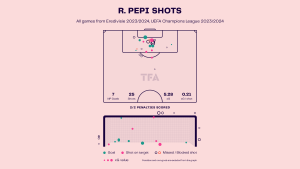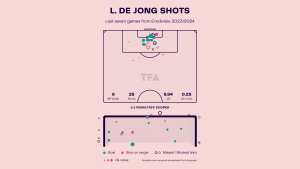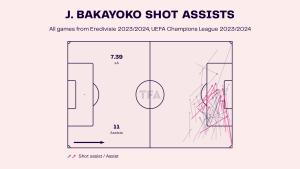Following a cagey match away at Sparta Rotterdam in the opening weekend of the season, Ajax welcomed Waalwijk to the Johan Cruijff Arena with the intention of picking up three points in a more convincing fashion. Meanwhile, Waalwijk, having lost their opening fixture away at Vitesse (a familiar club for Chelsea youngsters in recent years), were looking to open their account for the season.
At such an early stage of the season, it is very promising that Ajax can put on a performance with such dominance like they did against Waalwijk, picking up a 3-0 win. This tactical analysis will provide insights into the systems and tactics used by Ajax as they added three points to their Champions League qualification/Eredivisie title hunt.
Line-ups
Erik ten Hag changed very little in terms of personnel for his side – the only 2 changes to the starting 11 saw Lisandro Martinez fill in at left-back for the suspended Nicolas Tagliafico, and new signing Mohammed Kudus started in midfield next to Edson Alvarez. Again, players who did not feature heavily last season such as Zakaria Labyad and Perr Schuurs were given another platform to showcase their talents, and the remaining spots in the familiar 4-2-3-1 were taken by regular starters like Daly Blind, Quincy Promes, and Dusan Tadic
Visitors Waalwijk deployed a 4-4-1-1 with the intention of limiting Ajax’s play through midfield. Finn Stokkers led the line but saw little action as his side registered just 23 attacks in total. Anas Tahiri played a supporting role just behind Stokkers, with midfield depth being provided by Nico Olsak and Vurnon Anita. Luuk Wouters and Said Bakari occupied the full-back positions, with Ahmed Touba and Melle Muelensteen operating as central defenders.
Ajax – deadly in attack
As mentioned, Ajax looked like their old selves again in this fixture, attacking with better fluidity, confidence, and ability. While a great deal of their goalscoring is a result of their dominant possession game, they are also clinical in attacking through a transition, as seen below.

Straight away, we can see Waalwijk’s defence is extremely high up the pitch – not at all where you want to be getting caught out against an explosive Ajax attack. Having just recovered possession with a strong but seemingly fair challenge, Edson Alvarez instantly set his sights on launching his team into a counterattack in search of a second early goal.
His pass out wide to Tadic allowed Ajax to keep the opposition unorganised and unstable by applying width to the attack. Upon receiving the ball, Tadic showed good attacking instinct, knowing there would be a teammate making a darting run in behind the defence: in this case it was Antony.
The positional work done between Antony and Labyad created even more confusion between the Waalwijk defence, as they executed a criss-cross style run, allowing Antony to get into a dangerous area to receive the pass from Tadic, with Labyad already making his into the box. Antony took the ball nicely and squared it to Labyad, who slotted the ball into an empty net, completing an impressive and successful counterattack from Ajax. However, to the dismay of Ajax, the goal was ruled out moments later, after the referee reviewed Alvarez’s tackle and deemed it a foul.
While the goal did not stand, the point to focus on here is the execution of the counterattack from Ajax, a swift team attack that was very difficult to stop – 9 times out of 10, the goal would probably have stood.
Ajax seem to be applying a variety of methods when it comes to strategies that involve playing out from the back and dominating possession. An interesting one that they have incorporated lately is the use and position of full-backs on the side of the attack.

In this analysis, we see Ajax looking to progress through the thirds patiently, while Waalwijk have seemingly packed out the central area to force the home side out wide. Ajax, however, use this to their advantage. The circled player is Noussair Mazraoui, the Ajax right-back. Typically, we would expect to see an Ajax full-back a little higher, but much wider – hugging the touchline. His positioning in the middle means his marker will follow him into the middle, opening up spaces to attack wide – as we can see, right-winger Antony is available in acres of space thanks to Mazraoui’s positioning.
This gives Ajax a stronger chance of bypassing the Waalwijk midfield quickly and entering the attacking third to create a goalscoring opportunity. However, this would become predictable if Ajax opted for this method every time, which is why they strike a good balance – sometimes we did also see the full-backs supporting attacks in a more conventional, high and wide area.

This image shows exactly what is discussed above. On the ball is left-back Martinez, whose natural ability as a midfielder means he has the necessary on-the-ball skillset to apply himself as an attacking wide full-back. By locating himself in a wider area, it forces an opponent to come out and apply pressure, leaving some extra, potentially dangerous space in a more central position.
The idea of mixing between playing narrow and wide full-backs is creative and effective from Ajax as it gives the opponent a hard time in remaining defensively organised and cutting off the various passing options Ajax have in accordance to the wide/narrow system. Furthermore, when the wide-full back is in a position like this, it gives the winger on the same side (Tadic in this scenario), more of a licence to press on into a more advanced position, trying to get in behind the defence.

Above is an example of how Ajax have the ability to dominate possession in dangerous areas of the pitch. What doesn’t help Waalwijk out is the organisation of their midfield unit. While the back four is narrow and well organised, the midfielders – from the central players to the wide men, are essentially cancelling out the defence’s work in this phase of play.
Kudus, the man on the ball, is completely unchallenged, leaving him to play the next pass with no pressure. Luckily for Waalwijk, the pass attempt was a poor one and the right-back was on hand to intercept it. Quality of the pass aside, positionally, Ajax are very impressive in areas like this. The two highlighted central players are in a decent area to receive the ball: Labyad is lingering on the last defender and ready to make the run-in on goal, and Martinez has caught the Waalwijk right midfielder napping and makes a bursting run into a dangerous area – he was Kudus’ target. It is dominant and patient play like this that allows Ajax to threaten opposition defences so frequently. They recorded a total of 50 attacks in the game, attempting 21 shots on goal.
Ajax – keeping Waalwijk out
Even in games like this, where Ajax register 62% possession, defensive focus and consistency is vital. Credit where it’s due, Waalwijk had some success in playing attractive football to beat the press and progress from defence into midfield – on a couple of occasions Ajax would commit a player to a press, leaving an opponent free, and Waalwijk would a combination to bypass the pressing attempt. To stifle this, the Ajax front four would occasionally regroup to get into a shape that would eventually cause a turnover in possession most times.

As we can see above, Ajax adopted an approach that would initially invite the opposition to try and play out of defence, but with no actual passing options left available in short distance, thanks to the positioning of the Ajax front four. If the Waalwijk man on the ball attempted to find any of the teammates in the shot, the shape of this Ajax unit lets them block the pass.
This often led to Waalwijk looking to shift the ball forward in a more direct fashion, often looking for long balls to the opposite winger or full-back, but found little success playing this way. Ajax only executed a press when a trigger was involved – a bad touch for example, or during a transition where would see a counterpress from Ajax to win the ball back quickly.
Alongside causing difficulties for Waalwijk to play out defence, this also bought some time for Ajax’s defensive and midfield units to get fully organised and ready to stop the attack if that time came.

This image shows us how Ajax would typically set up when Waalwijk made a small amount of progress in attack. We can see how Ajax intentionally leave all three strikers up field with no defensive duties, which is a step they may have taken anyway, but Waalwijk’s red card allows Ajax to do this due to the numerical advantage. The positioning of the front three means Waalwijk must keep enough bodies back in case of a turnover in possession and Ajax execute a counterattack – limiting the number of attacking options the visitors had.
The shape of the midfield unit is also good from an Ajax perspective. The lack of attacking options for Waalwijk meant left-back Martinez was able to push higher up and effectively play as a defending midfielder momentarily. His presence higher up than his defensive teammates allowed the remaining midfielders to stay narrow in the middle of the park and block off any forward passes Waalwijk may want to attempt. Organisation and teamwork like this helped Ajax keep Waalwijk away from their goal, meaning the visitors never really looked like scoring.
Conclusion
Even if Waalwijk had finished the game with 11 players on the field, it is very unlikely that it would’ve affected the outcome – Ajax had too much quality and composure on the ball to find the weaknesses and gaps in the Waalwijk defence. Off the ball, the home side showed maturity, wisdom, and organisation, knowing they had cut off Waalwijk’s preferred way of attacking by not always applying a high-intensity press.
This was a thoroughly deserved victory for Ajax, which was also helped by their squad depth. The rule of allowing five substitutes arguably favours Ajax more than anybody else in the division, something they are using to their advantage with the quality they have amongst the substitutes. If Ajax can perform with such quality and confidence on a weekly basis, they will undoubtedly be in the title race yet again.










